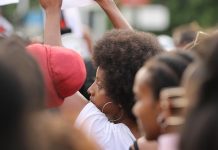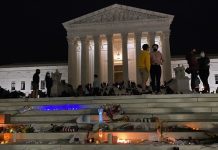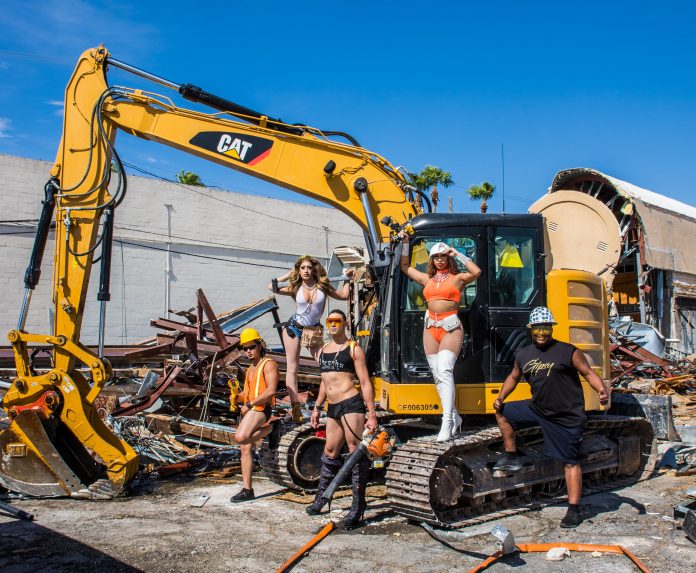The history of Las Vegas’s LGBTQ+community can be told through the history of its lesbian and gay bars — Maxine’s, The Red Barn, Le Café, Snick’s, and many others. None holds the history of gay Vegas though quite like Gipsy, located in the heart of the “Fruit Loop” at Paradise and Naples.
Born as a series of swank Italian restaurants owned by the likes of Robert Goulet and Don Rickles, the club emerged into the gay nightclub scene in the late 1970s as Disco Fever, party central for the pre-AIDS bacchanalia of drugs, sex and disco balls. Purchased by straight Armenian businessman George Adamian, “a wheeler dealer in business, but not in Vegas terms,” according to later owner Kerin Rodgers, Disco Fever reopened as the Village Station on Aug. 1, 1980, helmed by the colorful and controversial Marge Jacques, former owner of the popular gay restaurant club, Le Café.Jacques was a boisterous, out lesbian
and Le Café was the first gay bar to openly allow same-gender dancing. Gay historian Dennis McBride wrote that “the Las Vegas gay community first found its voice” at Le Café.
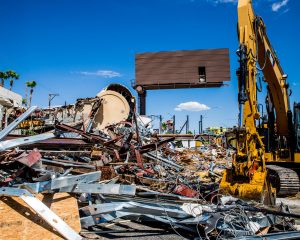
Le Café burned in 1978 in a mysterious arson fire that remains unsolved. Rumors flew that Jacques had set the fire herself. She blamed her business rival Camille Castro, owner of Le Bistro.
At the Village Station, Jacques opened the Backstage Bar, a stylish 40sstyle bistro as an escape from the noisy disco up front. Habitués included Joan Rivers and Siegfried and Roy, and the new club was a success.
It was less popular with Clark County authorities because of owner George Adamian’s alleged mob involvement and a dirty tricks letter writing campaign to the County Commission from Naples Street residents, supposedly instigated by Marge’s old rival Camille Castro, complaining about noise, drug use and “homosexual acts.”
Undercover police filmed the club’s wild 1980 Halloween party and showed
the footage at Adamian’s liquor license hearing. The film featured men kissing, scantily dressed in Bob Mackie designer costumes. Newspaper stories that ran about the party had headlines that read, “Fairies Flitting.” Adamian’s license was denied, and the club was shut down.
Jacques could not get a license herself because the licensing board still believed
that she was responsible for the Le Café fire.
In desperation, Jacques turned to prominent interior designer and nationally known political advocate, Kerin Rodgers, with a bid to buy the club from Adamian. Even with Rodgers’s political “juice,” she too struggled to get a license.
“What I went through to get that place open was hell!” Rodgers recalled in an oral history interview with Dennis McBride in 1998. Rodgers told the Spectrum, “I honestly don’t know about the Le Cafe fire. Marge and I were friends but everyone thought we were lovers. I never asked her about the fire.”
Rodgers says her home was ransacked by the Las Vegas Metropolitan Police’s Privileged Investigations Bureau trying to find dirt on her, “Ever way but upside down.” She told McBride that Metro also attempted to entrap her with a $10,000 bribe.
Rodgers remembers, “It wasn’t a fight to get Gipsy open. It was a fight for the gay community.” She says that Gipsy legitimized the idea of a gay club.
The club reopened on April 1, 1981 rechristened from Village Station to Gipsy in homage to the “show kids,” the 80s Las Vegas euphemism for the gays and lesbians who patronized the club. Rodgers says the club was financed on a “lick and a promise.” She modeled the club’s design on such famous discos as Madame Arthur’s in Copenhagen. Rodgers and Marge Jacques drove to pick-up the Gipsy sign from a closed club in Los Angeles and on the way back to Las Vegas the sign blew off the top of Rodgers’s Volvo into the desert.
Gipsy was the place to party in the 80s, popular not just with the LGBTQ community but with local celebrities as well, like Cher, Debbie Reynolds, Rip Taylor, and Sammy Davis, Jr. Rodgers recalled that Liberace would often come in “with that twerpy kid (Scott Thorson) who later sued him.” The club gained an international renown.
Police harassment continued. At the time, Clark County’s liquor and gaming code read that any business that catered to homosexuals, hookers, hoodlums, and hobos could lose their license. Rodgers said, “We called it the 4Hs.”
The licensing board asked Rodgers, “Are you going to encourage homosexuals to attend your place of business?” An exasperated Rodgers asked, “What do you want me to do? Card everybody? [Ask] ‘Who do you sleep with?’ I mean!”
At her license hearing, many people came forward and spoke up for Kerin, including Grant Sawyer, Mahlon Brown and Judge Harry Claiborne. Rodgers told the Spectrum that prominent Judge Claiborne testified for her. She quotes him as having told the commission, “I know Kerin well. She’ll card every homo, hoe, hoodlum and hobo and won’t let them in the club. What type of (ID) card do you plan to issue them, so she’ll know who they are?”
During a filming at Gipsy of “The Great American Strip-Off” for the Playboy Network, the fire department tried to shut the club down for overcrowding. Vice cops frequently harassed customers, looking for fake IDs from college students who Rodgers claimed were plants from Mothers Against Drunk Driving.
Gay historian Dennis McBride recalled, “There was a law in the books that an individual couldn’t wear more than two or three items of clothing from the opposite sex which is why they tried to stop [Marge Jacques] from having drag shows.”
Rodgers got around that when she got the idea to throw a big party celebrating the opening of Donn Arden’s “Jubilee!” at Bally’s. She invited patrons to wear costumes from shows currently running on the Strip. She told Dennis McBride in his oral history interview that she reasoned, “Nobody can put us down if we have costumes from
existing shows,” no matter how scanty those costumes may have been, or which gender was wearing which gender’s costumes. “It was just wonderful!” Rodgers said.
She recalls her LGBTQ patrons, “It takes a good-hearted person to be out-going and fun-loving and want to share and do the ‘Y-M-C-A’ kind of thing.”
After feuding between Jacques and Rodgers, Rodgers sold the club in 1983 to Chuck Melfi, an openly gay Las Vegas baccarat dealer, later turned horse rancher.
Rodgers explained to the Spectrum, “Marge wanted to buy the club but I was warned by some commissioners that if I sold to Marge, they would never license her. They were still convinced that she burned down her old club, Le Cafe and said they would never license her. My name would remain on the license while any new owner applied for their own approval, so there was no way I could sell to Kerin. “Marge was so angry, she threatened me but I hald already sold to Chuck and wasn’t going to be intimidated. I was a traditional, Irish-Catholic girl, so I just prayed Marge away and it worked.”
Melfi explained one of his reasons for buying the club, “I was dating a bartender there and I wanted to buy the club just to fire him.” He said, “The day I bought it, he quit.”
“When I bought Gipsy,” Melfi said, “The County Commission wanted it closed because it was a hangout for undesirables. I said I would clean it up and make it a decent gay establishment.”
Initially there was the usual police harassment gay clubs had come to expect. Melfi said, “They would come at midnight on a Saturday night, busiest night of the week, and clear out the place.”
According to gay historian Dennis McBride, the Nevada Gay Action League met with then Clark County Undersheriff John Moran who was campaigning for Sheriff in 1982 and made a deal to support Moran’s candidacy in the LGBTQ community, if Moran agreed to pull back Las Vegas Metro’s harassment of gay bars. Though harassment did ease up, it did not completely stop. Still, Melfi said he was able to approach the Sheriff about the
problems he was having, and the harassment of Gipsy stopped.
Under Melfi’s ownership Gipsy was openly identified as a gay club for the first time (instead of the “show kids” euphemism for gay). Melfi stood with the gay community in the emerging AIDS crisis and held Las Vegas’s firstm AIDS benefit at the club on Nov. 13, 1983. Dennis McBride wrote that it was at that benefit that safe sex was first
publicly mentioned in Las Vegas.
Gipsy’s became a meeting place for LGBTQ community clubs and organizations and was a sponsor for Las Vegas’s first Gay Pride celebrations. Melfi said, “It was great fun for the 16 – 18 years I owned it.” “Gipsy started it all,” Melfi said. The “Fruit Loop” at Paradise and Naples became the “gayborhood” for Las Vegas. “The gay community was a lot of fun. There wasn’t the back-biting stuff all the time,” Melfi said. “Most were closeted. Gipsy was their escape.”
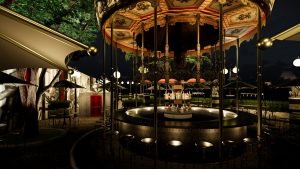
Along with celebrities like Barry Manilow and Cher, the club attracted prominent gay community leaders like Robert Forbuss, namesake for the LGBTQ Center, and, Melfi recalls, “that gay lawyer.” Pioneer drag performer Kenny Kerr told Dennis McBride in a 2001 oral history interview, “Gipsy’s been a great place for me to meet husbands!”
“Halloween was always the big night,” Melfi said. “The costumes and everything. It was special.” He said, “We’d open at 10 p.m. and still be open at noon the next day.”
But on August 8, 1988, ten years after the Le Café fire, the Gipsy was torched by an arsonist. Melfi believes that the fire was started by a Molotov cocktail that was thrown through the unused front doors of the club facing Paradise and into the performer dressing rooms by the jilted boyfriend of one of the bartenders.
Kerr was performing on the stage that evening surrounded by hundreds of balloons, which suddenly began to pop from the heat. “Pop, pop!” Kerr recalled the sound in an oral history interview with Dennis McBride in 2001. “Pop, pop, pop! The heat was breaking the balloons,” Kerr remembers the flames shooting up to the ceiling, “right over us.” He says he calmly told the audience of about 330 people, “Everybody calmly go out the back doors [the club’s front doors exiting into the parking lot]. Don’t push. Please take your time.” He added with a laugh, “The first thing I yelled out to my dresser, ‘Russell, grab my dresses!’”
Kerr said, “You couldn’t see a thing because the smoke was so black and there were no lights.” After the fire, Melfi remembers the piles of shoes lost by the fleeing patrons. He said that the heat of the fire melted the club’s cash registers. The arson remains unsolved and there is some evidence that this might be due to the lackadaisical response of the Clark County Fire Department.
With a fire station location just blocks away on Flamingo, Las Vegas Spectrum publisher Rob Schlegel, who then published the gay Las Vegas Bohemian Bugle, reported that it took firefighters some fifteen minutes to begin to effectively dose the flames. Witnesses reported in fire investigation testimony which later “disappeared” that they overheard the fire crew captain saying, “It’s only a faggot place. Let it burn.”
Melfi confirmed to the Spectrum that he heard the fire captain approached him and said, “I’m the ‘faggot’ who owns this place! Put it out.” He said, “They got to work.”
Among those saved that night by Kenny Kerr’s calm demeanor was Frank Marino, his arch-rival from “An Evening at La Cage.” Kerr said, “I had a beaded gown on that had a big Balenciaga bottom.” He recalls Frank Marino said to him, “I knew you would get out,” and ripped the dress down the front to help Kerr out of it.
More than just a fun dance club was lost that night. Gipsy at the time was the largest employer of openly gay people in the state and some 50 workers found themselves unemployed. Dennis McBride reports that same month the LGBTQ-identified Metropolitan Community Church in an act of community solidarity held a benefit for the out- of-work employees.
As a Christmas present for a community battling the AIDS epidemic, Melfi reopened Gipsy in December 1988, “bigger and better than ever.” Melfi recalls, “After we rebuilt, on opening night, I walk in and he was sitting at the bar,” referring to the jilted boyfriend who he believes started the fire. “He had such a smug look on his face. Needless to say, I threw him out.”
Melfi said, “Gipsy was very popular. We just had to unlock the doors and they came.” He said, “We opened at 10 p.m. and it would be dead as a doornail until 12:30 p.m. and then it was so packed you couldn’t move until 7 a.m.”
The club continued to be the LGBTQ community’s flag ship into the 90s. Melfi who is HIV positive said that at the time “I was not feeling well and, thinking I only had a couple of years, moved to Oregon.” Melfi and his husband, bar manager Paul Morris, had made a trip to rural Oregon and Melfi fell in love with the state. He and Paul purchased a 10-acre horse ranch near Medford where they happily live to this day. Melfi sold Gipsy to gay entrepreneur Paul San Filipo in 1994 and the club continued its reign as the LGBTQ
dance club into the new century, even as new clubs such as Piranha, also owned by San Filipo and gay real estate broker, Jerry Masini, began to attract a younger LGBTQ crowd.
The competition began to get tougher when the unspoken ban of gay clubs on the Strip was broken by clubs like Krave and Pure. Sensing the need for a makeover, in 2013 San Filipo reached out to the popular reality TV show Bar Rescue.
Still under a confidentiality agreement, San Filipo stays dumb about what went down behind the scenes of the devastating TV program that made him look like an ass. He said, “Even a reality TV show is still a TV show” and says that much of what went on was pre-scripted to deliberately make him look as bad as possible. Like a home that is staged by a Realtor for a fast sell, the bar’s TV refurbishing was skin deep, with fabrics and wall coverings that San Filipo said did not even meet code. A sign behind the bar announcing, “Have a Gay Ol’ Time,” was taken down before the show aired. One Gipsy employee complained to a local gay publication, “That’s like putting in an African American bar something like, ‘Have a Black Ol’ Time.’” San Filipo immediately ripped out the faux makeover and spent 2 million on a true remodel that he believed would bring the club back its old popularity with the LGBTQ community. He envisioned a day club and ultra
lounge, complete with pool.
Immediately, he ran into problems. The county decided to take an extra 20 feet of his land for future Paradise Road expansion, which cut into where the pool was being dug. Then came contractor problems, lawsuits and litigation. All of which kept the club shuddered until now.
San Filipo is preparing to resurrect a brand new Gipsy and remains undaunted in the face of the coronavirus shutdown. Quickly realizing that it would be more cost-effective to tear down the old structure than to bring it up to code, San Filipo sees the rebuild as an opportunity to create the first Las Vegas club built to COVID-19 safety standards.
Phase one of the rebuild will be to make improvements to bring the property up to standard for all of the curbing, parking, and street lighting. Phase 2 will be the first floor of the new club—a spacious, open air bar encircling a carousel bar. Phase 3 will be a second-floor disco.
Originally, San Filipo had hoped to have the first floor opened and ready for business by January 2021, but due to coronavirus-related construction inspection slowdowns, he now expects the opening of the downstairs open air bar to be May – June 2021.
The over-all look of the 10,000 square feet club will be a contemporary Pirates of the Caribbean—“think the look of the patio at Restoration Hardware in Tivoli Village,” San Filipo says.
Given the precarious business prospects for a new club opening at the possible height of the second wave of the coronavirus, San Filipo and his personal partner and director of operations, Christopher Rojas, had considered building a shopping center on the property instead. He admits “It’s a risk” going forward with the new Gipsy, but he
says, “I have a passion for this business and I’m not sparing any expense.” He expects the rebuild will cost approximately $5 million.
San Filipo wants Gipsy to be “a place to be proud of” for the gay community. He remembers first going to Gipsy when he was 16, using a fake ID (Don’t tell MADD or Chuck Melfi). He said back then it was black with a turquoise neon strip, “It was a dive bar.”
As Las Vegas’s first gay dance club, San Filipo said that Gipsy throughout its long life has attracted some of the biggest celebrities in Vegas. He said when he ran the club in the early 2000s, “Siegfried and Roy had their own booth in the corner.”
He remembers the nights when Janet Jackson, Cher, Joan Rivers, Neil Sedaka, Bette Midler, Liberace and Scott Thorson, RuPaul and Kenny Kerr would visit the club, and envisions the future stars who will continue the Gipsy legend.
Special thanks to Su Kim Chung, Ph.D, Head of Public Services, University Libraries Special Collections &; Archives, University of Nevada, Las Vegas for making access of the LGBTQ Oral History Archives possible during
the coronavirus shutdown.
Thanks also to gay historian Dennis McBride for preserving Las Vegas’s LGBTQ history with his oral history interviews. As a reader can quickly assess, I am indebted to his magisterial “Out of the Neon
Closet: Queer Community in the Silver State” for this article. Read it for the full story, for LGBTQ history from 1861 to 2016.








